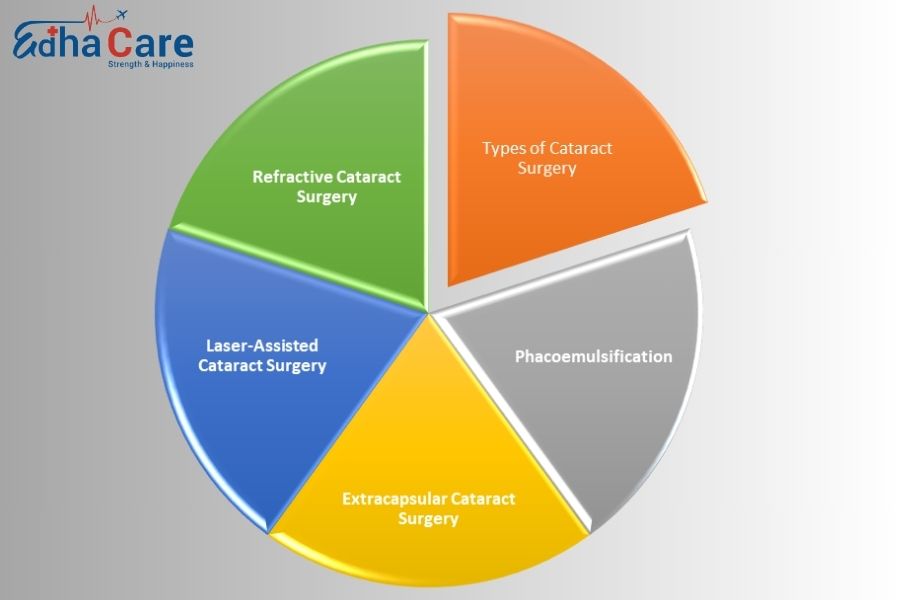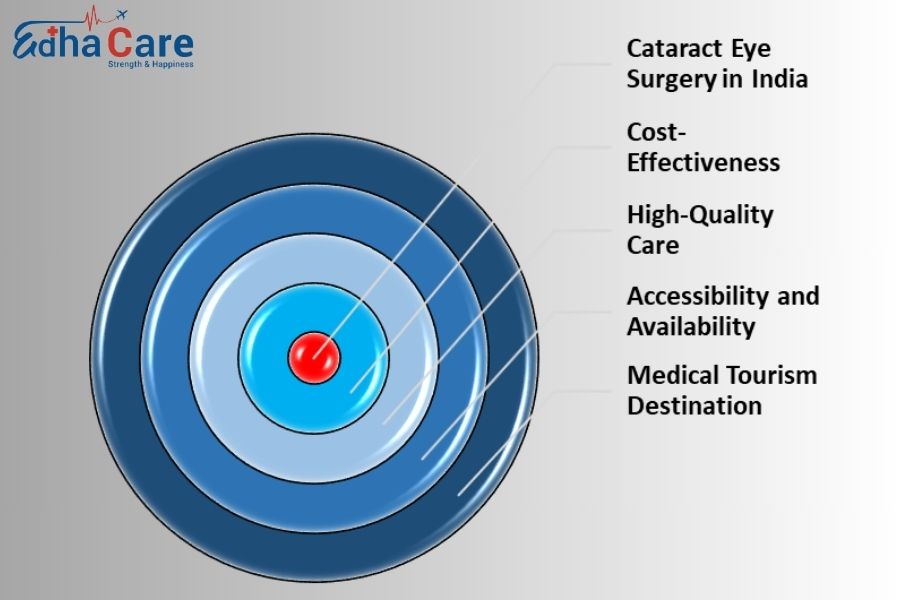Medical tourism involves traveling to another country for medical treatment, often due to lower costs, shorter wait times, or access to specialized care not available locally. Cataract eye surgery in India is a prime example of this trend, renowned for its quality and affordability. The procedure, performed by skilled ophthalmologists using state-of-the-art technology, attracts patients globally seeking improved vision and enhanced quality of life.
In compare to the USA, where cataract surgery costs between $3,000 to $5,000 per eye, in India, the same procedure ranges from $700 to $1,500, covering all expenses. Despite the lower price, Indian hospitals maintain high standards, ensuring patients receive excellent care for their cataract eye surgery needs. This significant cost difference, combined with comparable quality, makes India a preferred destination for those seeking affordable treatment without compromising on excellence.
What is Cataract Surgery?
Cataract surgery is a procedure to fix cataracts, a problem with your eyes. When you have cataracts, the lens in your eye gets cloudy, which makes it hard to see clearly. Cataract surgery helps by taking out the cloudy lens and putting in a new, clear one.
During Cataract Eye Surgery in India, your eye is numbed so you don’t feel anything. Then, the doctor makes a tiny cut in your eye and uses a special tool to break up the cloudy lens. After that, they put in a new lens to help you see better.
It’s a simple surgery that doesn’t take long, and you can usually go home the same day. Many people find that their vision gets much better after cataract surgery, and they don’t need glasses as much. So, if you have trouble seeing because of cataracts, cataract eye surgery in India could be a good option for you.
What are the Signs You Need Cataract Surgery
If you’re experiencing changes in your vision, particularly blurry or foggy vision, especially noticeable at night or in bright light, it might be time to consider cataract surgery. This common eye condition can cause your vision to deteriorate gradually, making it difficult to see clearly and affecting your overall quality of life. Cataract Surgery becomes necessary when you’re facing certain signs.
Here are some easy-to-spot signs:

- Blurry Vision: If your vision gets blurry, especially at night or in bright light, it could mean you have cataracts. Things might seem foggy or less clear than before.
- Difficulty Seeing at Night: If you struggle to see clearly in low-light situations, like when driving at night, it might be due to cataracts. You might notice halos around lights or find it hard to see in dimly lit places.
- Colors Look Faded: Cataracts can make colors seem dull or less vibrant than they used to be. You might find it hard to distinguish between shades or notice a yellowish tint to everything.
- Double Vision: Seeing double or experiencing multiple images of the same object can be a sign of cataracts. This can make it challenging to focus and can affect your depth perception.
- Sensitivity to Light: Cataracts can make your eyes more sensitive to light, causing glare or discomfort when exposed to bright lights or sunlight.
- Frequent Changes in Eyeglass Prescription: If you find yourself needing frequent changes in your eyeglass prescription but still struggle with vision, it could indicate cataracts.
If you notice these signs affecting your vision and daily life, it’s essential to consult an eye specialist. They can determine if cataract surgery is the right option for you and help restore your clear vision.
Types of Cataract Surgery
When it comes to cataract surgery, there are several approaches that your eye surgeon may consider based on your individual needs and the severity of your cataracts. Let’s delve into the various types of cataract surgery:

1. Phacoemulsification
- Phacoemulsification, often referred to as “phaco,” is the most common and widely used technique for cataract removal. During this procedure, the surgeon makes a small incision in the eye and uses ultrasonic vibrations to break up the cloudy lens into tiny fragments.
- These fragments are then suctioned out of the eye, leaving behind a clear space for the insertion of an artificial intraocular lens (IOL). Phacoemulsification is a minimally invasive procedure with a rapid recovery time and minimal risk of complications.
2. Extracapsular Cataract Surgery (ECCE):
- Extracapsular cataract surgery is an older technique that involves removing the cloudy lens in one piece, rather than breaking it up into fragments.
- This approach requires a larger incision than phacoemulsification and may be recommended for individuals with advanced cataracts or certain eye conditions that make phacoemulsification challenging. While ECCE is effective, it has a longer recovery time and a slightly higher risk of complications compared to phacoemulsification.
3. Laser-Assisted Cataract Surgery:
- Laser-assisted cataract surgery, also known as femtosecond laser cataract surgery, is a cutting-edge approach that utilizes laser technology to perform key steps of the cataract surgery procedure. The laser is used to create precise incisions in the cornea, break up the cataract into smaller pieces, and soften the lens for easier removal.
- This technique offers enhanced precision, potentially reducing the risk of complications and improving visual outcomes. However, laser-assisted cataract surgery may not be suitable for all patients and is typically more expensive than traditional methods.
4. Refractive Cataract Surgery:
- Refractive cataract surgery combines cataract removal with refractive procedures aimed at correcting other vision problems, such as nearsightedness, farsightedness, or astigmatism.
- This approach allows patients to address both their cataracts and refractive errors simultaneously, reducing or eliminating the need for glasses or contact lenses after surgery. Refractive cataract surgery may involve the use of specialized IOLs, such as multifocal or toric lenses, to achieve the desired visual outcome.
Cost of Cataract Surgery
Cataract surgery is an essential medical procedure aimed at restoring clear vision for individuals affected by cataracts. However, the cost of this surgery can vary significantly depending on the country where it’s performed. Let’s explore the comparative costs of cataract surgery in different nations:
In the United States, cataract surgery is widely available but can be relatively expensive. On average, the cost of cataract surgery per eye ranges from $3,000 to $5,000. This cost includes the surgeon’s fees, hospital charges, and the cost of the intraocular lens (IOL) implanted during the procedure. However, it’s important to note that the actual cost may vary based on factors such as the type of IOL chosen and any additional pre-operative or post-operative care required.
Cost of Cataract Eye Surgery in india is approximately $800 to $1,500. This significantly lower cost includes all aspects of the procedure, including surgeon’s fees, hospital charges, and the cost of the IOL. Despite the lower cost, patients can expect high-quality treatment delivered by skilled ophthalmic surgeons.
Exploring the Advantages of Cataract Eye Surgery in India
Cataract surgery is a transformative procedure that can significantly improve vision and enhance quality of life for individuals affected by cataracts. When considering where to undergo this surgery, there are several compelling benefits to choosing India as your destination:

1. Cost-Effectiveness:
- One of the most notable advantages of cataract surgery in India is its affordability. The cost of cataract surgery in India is significantly lower compared to many Western countries, including the United States and Europe.
- Cost-effectiveness extends to all aspects of the procedure, including surgeon’s fees, hospital charges, and the cost of intraocular lenses (IOLs). As a result, patients can receive high-quality treatment at a fraction of the cost, making cataract surgery in India an attractive option for those seeking affordable healthcare solutions.
2. High-Quality Care:
Despite its lower cost, cataract surgery in India does not compromise on quality. The country is home to a vast network of highly skilled ophthalmic surgeons who are trained in the latest techniques and technologies. State-of-the-art medical facilities equipped with advanced equipment ensure that patients receive world-class treatment and care.
3. Accessibility and Availability:
- Cataract surgery services are readily available across India, with numerous hospitals and eye care centers offering comprehensive treatment options. Patients have access to a wide range of surgical facilities, ensuring that they can find a suitable provider to meet their specific needs.
- Moreover, the procedure is performed on an outpatient basis, allowing patients to return home on the same day, minimizing inconvenience and downtime.
4. Medical Tourism Destination:
- India has emerged as a premier destination for medical tourism, attracting patients from around the globe seeking affordable and high-quality healthcare services. Beyond cataract surgery, the country offers a plethora of tourist attractions, cultural experiences, and hospitality options, making it an ideal destination for combining medical treatment with leisure travel.
- Patients can enjoy the unique blend of traditional Indian hospitality and modern healthcare infrastructure, ensuring a comfortable and rewarding experience during their medical journey.
Procedure OF Cataract eye surgery in India
Cataract surgery is typically performed as an outpatient procedure under local anesthesia. The surgeon makes a small incision in the eye and uses ultrasound technology to break up and remove the cloudy lens. Then, an artificial intraocular lens (IOL) is inserted to replace the natural lens. This procedure is known as phacoemulsification and is minimally invasive, with a short recovery time.
The procedure of cataract eye surgery in India involves several intricate steps designed to restore clear vision and enhance the quality of life for patients suffering from cataracts.
1. Pre-operative Assessment:
- Before the surgery, patients undergo a comprehensive eye examination by a skilled ophthalmologist. This assessment helps determine the severity of the cataract and evaluates the overall health of the eye.
- Advanced diagnostic tools, such as optical coherence tomography (OCT) and biometry, may be used to precisely measure the eye’s dimensions and aid in selecting the appropriate intraocular lens (IOL) for implantation.
2. Anesthesia:
During the surgical procedure, patients are typically given local anesthesia to numb the eye and ensure comfort throughout the operation. In some cases, sedation may also be administered to help patients relax during the surgery.
3. Incision:
- A small incision is made in the eye to access the clouded lens. Modern cataract surgery techniques, such as phacoemulsification, utilize ultrasonic energy to break up the cataract into tiny fragments, which are then gently suctioned out of the eye.
- This minimally invasive approach allows for quicker healing and reduced risk of complications.
4. Cataract Removal:
- With the cataract fragments removed, the next step involves implanting the artificial intraocular lens (IOL). The choice of IOL depends on various factors, including the patient’s vision requirements, lifestyle, and any pre-existing eye conditions.
- Options may include monofocal, multifocal, or toric lenses, each offering unique advantages in addressing specific visual needs.
5. IOL Implantation:
- The selected IOL is carefully inserted into the eye through the same incision used for cataract removal. Specialized instruments are used to position the lens accurately within the eye, ensuring optimal visual outcomes.
- Some advanced IOLs may also incorporate features to correct astigmatism or provide enhanced near and distance vision, reducing the need for glasses or contact lenses after surgery.
6. Closure and Recovery
- Once the IOL is securely in place, the incision is typically self-sealing and does not require stitches. A protective shield may be placed over the eye temporarily to prevent injury and facilitate the healing process.
- Patients are advised to rest and avoid strenuous activities in the immediate post-operative period. Prescription eye drops are often prescribed to prevent infection, reduce inflammation, and promote healing.
Conclusion
Cataract eye surgery in India provides an excellent solution for individuals suffering from cataracts, offering high-quality treatment at a fraction of the cost compared to Western countries. With skilled surgeons, advanced technology, and the allure of medical tourism, India has positioned itself as a premier destination for cataract surgery, catering to both local and international patients alike. If you’re considering cataract surgery, exploring the option of having it done in India could be a wise and rewarding decision for both your vision and your wallet.

